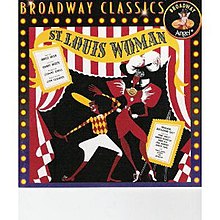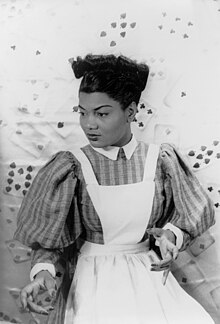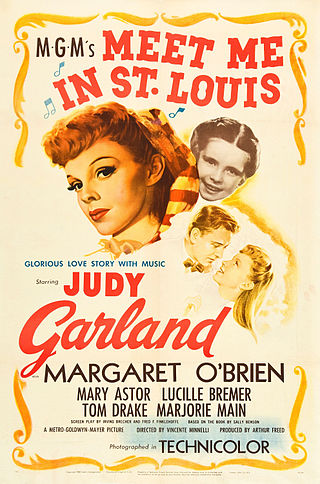
Meet Me in St. Louis is a 1944 American Christmas musical film made by Metro-Goldwyn-Mayer. Divided into a series of seasonal vignettes, starting with Summer 1903, it relates the story of a year in the life of the Smith family in St. Louis leading up to the opening of the Louisiana Purchase Exposition in the spring of 1904. The film stars Judy Garland, Margaret O'Brien, Mary Astor, Lucille Bremer, Tom Drake, Leon Ames, Marjorie Main, June Lockhart and Joan Carroll.

The cakewalk was a dance developed from the "prize walks" held in the mid-19th century, generally at get-togethers on Black slave plantations before and after emancipation in the Southern United States. Alternative names for the original form of the dance were "chalkline-walk", and the "walk-around". It was originally a processional partner dance performed with comical formality, and may have developed as a subtle mockery of the mannered dances of white slaveholders.

Harold Arlen was an American composer of popular music, who composed over 500 songs, a number of which have become known worldwide. In addition to composing the songs for the 1939 film The Wizard of Oz, including "Over the Rainbow", which won him the Oscar for Best Original Song, he was nominated as composer for 8 other Oscar awards. Arlen is a highly regarded contributor to the Great American Songbook. "Over the Rainbow" was voted the 20th century's No. 1 song by the RIAA and the NEA.

Countee Cullen was an American poet, novelist, children's writer, and playwright, particularly well known during the Harlem Renaissance.

"The Saint Louis Blues" is a popular American song composed by W. C. Handy in the blues style and published in September 1914. It was one of the first blues songs to succeed as a pop song and remains a fundamental part of jazz musicians' repertoire. Benny Goodman, Louis Armstrong, Cab Calloway, Bing Crosby, Bessie Smith, Eartha Kitt, Count Basie, Glenn Miller, Guy Lombardo, Peanuts Hucko, and the Boston Pops Orchestra are among the artists who have recorded it. The song has been called "the jazzman's Hamlet". Composer William Grant Still arranged a version of the song in 1916 while working with Handy.

Arna Wendell Bontemps was an American poet, novelist and librarian, and a noted member of the Harlem Renaissance.

Foofur is an American children's television series from Kissyfur creator Phil Mendez that was produced by Hanna-Barbera Productions with SEPP International S.A. Airing on NBC from 1986 to 1988, the show was about the everyday misadventures of the skinny blue protagonist dog in Willowby. A comic book series based on the cartoon was produced by and released from Star Comics.
"Blues in the Night" is a popular blues song which has become a pop standard and is generally considered to be part of the Great American Songbook. The music was written by Harold Arlen, the lyrics by Johnny Mercer, for a 1941 film begun with the working title Hot Nocturne, but finally released as Blues in the Night. The song is sung in the film by William Gillespie.

"One for My Baby (and One More for the Road)" is a song written by Harold Arlen and Johnny Mercer for the movie musical The Sky's the Limit (1943) and first performed in the film by Fred Astaire.
"The Man that Got Away" is a torch song, published in 1953 and written for the 1954 version of the film A Star Is Born. The music was written by Harold Arlen, and the lyrics by Ira Gershwin. In 1954, it was nominated for the Academy Award for Best Original Song. In 2004, Judy Garland's performance of the song was selected by the American Film Institute as the eleventh greatest song in American cinema history.
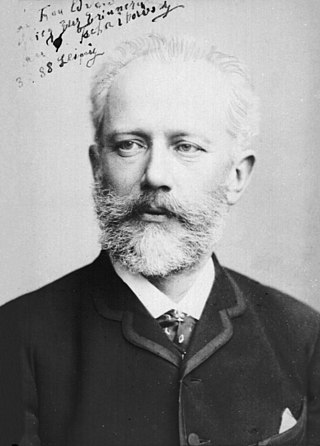
The Sleeping Beauty is a ballet in a prologue and three acts to music by Pyotr Ilyich Tchaikovsky, his Opus 66, completed in 1889. It is the second of his three ballets and, at 160 minutes, his second-longest work in any genre. The original scenario was by Ivan Vsevolozhsky after Perrault's La belle au bois dormant, or The Beauty Sleeping in the Forest; the first choreographer was Marius Petipa. The premiere took place at the Mariinsky Theatre in St. Petersburg on January 15, 1890, and from that year forward The Sleeping Beauty has remained one of the most famous of all ballets.
"Come Rain or Come Shine" is a popular music song, with music by Harold Arlen and lyrics by Johnny Mercer. It was written for the Broadway musical St. Louis Woman, which opened on March 30, 1946, and closed after 113 performances.

Blues in the Night is a 1941 American musical in the film noir style directed by Anatole Litvak and starring Priscilla Lane, Richard Whorf, Betty Field, Lloyd Nolan, Elia Kazan, and Jack Carson. It was released by Warner Brothers. The project began filming with the working title Hot Nocturne, the play upon which it is based, but was eventually named after its principal musical number "Blues in the Night", which became a popular hit. The film was nominated for a Best Song Oscar for "Blues in the Night".
"Any Place I Hang My Hat Is Home" is a popular song with music by Harold Arlen and lyrics by Johnny Mercer.

Belle of the Nineties is a 1934 American Western film directed by Leo McCarey and released by Paramount Pictures. Mae West's fourth motion picture, it was based on her original story It Ain't No Sin, which was also to be the film's title until censors objected. Johnny Mack Brown, Duke Ellington, and Katherine DeMille are also in the cast. The film is noted for being the premiere performance of the jazz standard "My Old Flame", performed by West with the Duke Ellington Orchestra.

How Glory Goes is the second album from Audra McDonald, released in 2000. Unlike her debut album Way Back to Paradise, which featured songs from younger composers, this album contains a mixture of new and old songs, mostly from musical theatre. Five of the songs were written by Harold Arlen, and two by Adam Guettel, including the title track.

Betsy Graves Reyneau (1888–1964) was an American painter, best known for a series of paintings of prominent African Americans for the exhibition “Portraits of Outstanding Americans of Negro Origin” that, with those by Laura Wheeler Waring and under the Harmon Foundation, toured the United States from 1944 to 1954. A granddaughter of Michigan Supreme Court Justice Benjamin F. Graves, Reyneau's sitters included Mary McLeod Bethune, George Washington Carver, Joe Louis, and Thurgood Marshall. Reyneau's portrait of Carver, the most famous, was the first of an African American to enter a national American collection.
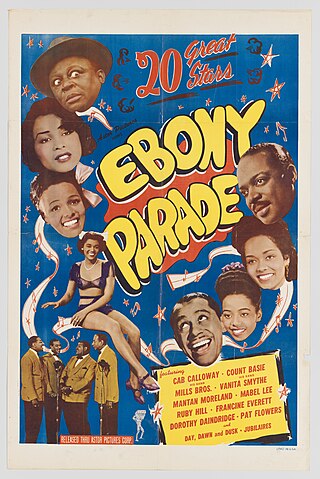
Ruby Hill Turner was an American singer who starred in the 1946 Broadway production St. Louis Woman. She performed the hit songs "Come Rain or Come Shine" and Any Place I Hang My Hat Is Home for more than 100 showings. Capitol Records recorded her. She featured in the 1947 musical compilation film Ebony Parade made using archival clips. She performed at New York City's Cotton Club and the Ed Sullivan Show.
Lemuel Ayers was an American costume designer, scenic designer, lighting designer, and producer who had a prolific career on Broadway from 1939 until his death from cancer in 1955 at the age of 40. He designed sets for a total of 30 Broadway plays and musicals during his career, including both the original 1943 production and 1951 revival of Rodgers and Hammerstein's Pulitzer Prize winning musical Oklahoma!. Ayers also designed both costumes and sets for several productions, including St. Louis Woman (1946), My Darlin' Aida (1952), Kismet (1953), and The Pajama Game (1954). He served as lighting designer and scenic designer for one production, Harold Arlen's Bloomer Girl (1944), and he designed the entire productions of Song of Norway (1944) and Arthur Schwartz's Inside U.S.A. (1948). He won three Tony Awards in 1949, for the original production of Cole Porter's Kiss Me, Kate (1948), for which he designed both costumes and sets and worked as producer. He also directed portions of the 1945 musical film Ziegfeld Follies for MGM for which he also served as art director. He also worked as art director for the musical film Meet Me in St. Louis with Judy Garland and directed portions of the musical film Kiss Me Kate (1953).
